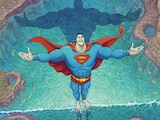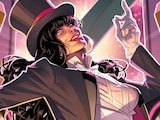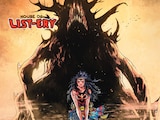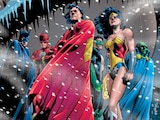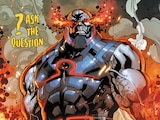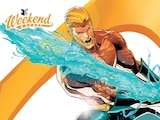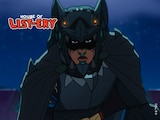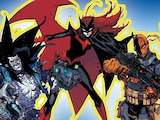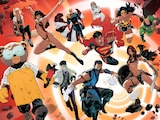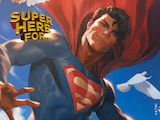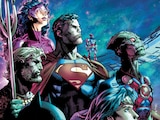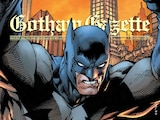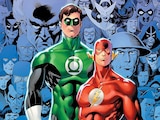The Penguin looms large in the psyches of Batman readers. If you’re a fan of a certain age, I’m sure you remember the first time you saw Danny Devito’s Penguin in Batman Returns bite off the nose of a helpless victim, blood spewing everywhere. For me, I’ve been a big fan of the Penguin ever since I saw that movie as a kid, which is why I was so delighted to dive into volume one of Tom King, Rafael de Latorre, Marcelo Maiolo and Clayton Cowles’s The Penguin.
For those who haven’t been reading the series, this little bird has landed in some hot water. After faking his own death and siccing the terrifying Failsafe robot against the Dark Knight in the pages of Chip Zdarsky and Jorge Jiménez’s Batman, Oswald Cobblepot has been lying low in Metropolis of all places. He’s got a nose job, a new name and lives a quiet life as the owner of Metropolis’s dingiest floral shop.

But because he is legally dead now, Oswald’s troubles have only begun. Someone has been viciously murdering his kids (yes, the Penguin has biological children) right when they were poised to inherit the fortune he had made in Gotham’s criminal underground, leaving the twins Addison and Aiden Cobblepot in control of the Iceberg Lounge. Now, the Penguin must assemble a team of allies to win back the empire he once left.
All of which got me thinking again about Batman Returns. If you remember, the film is full of freaks and colorful characters, from Michelle Pfeiffer’s iconic Catwoman, to Christopher Walken’s Max Shreck, to those animatronic penguins wearing rockets, to the Dark Knight himself. Tim Burton’s vision of Gotham characterized it as a deeply strange place where babies could be abandoned in the sewers, only to rise up as mayoral candidates decades later. Batman Returns hinges upon its focus on multiple characters, and how their individual quirks form a composite image of Gotham itself.
The first volume of The Penguin takes a similar approach. Writer Tom King is a chameleon when it comes to crafting the unique voice of a character’s internal monologue—just look at his work in Mister Miracle, The Human Target, Grayson and Rorschach, just to name a few. In The Penguin, the narrator of each issue changes between different characters, however minor, that the Penguin comes across. This creative choice works to create a vision of Metropolis and Gotham City through the thoughts of its citizens, painting a colorful picture that feels within the same spirit of Batman Returns.

The Penguin builds off of the character’s appearance in Batman Returns by emphasizing how the Penguin exists as a freak only within the minds of the people he comes across. That is, Oswald’s grotesqueness is socially constructed, and isn’t an innate quality. At the very beginning of the story, Oswald Cobblepot is a mild-mannered older gentleman, even when government agents who know his real identity try to push his buttons. Oswald’s refusal to take the bait of the agents searching for the Penguin shows that he understands the performative nature of “normalcy.”
This idea also extends to the team that the Penguin recruits to help him take back Gotham. In true Tom King fashion, obscure characters from the annals of DC history come out and are placed beneath an illuminating, psychological microscope. The assembly of this team breaks the conventions of team-building montages in conventional comic book and superhero stories. Instead of the characters coming together quickly, with a line or two explaining what their shtick is, King and artist Rafael de Latorre sit them down at a table and have them share their dreams and demons while looking us in the eye. In The Penguin, it’s not what the team does once they all get together that matters, it’s also who they are and who they were before all this began that’s just as important.

In this sense, King continues his interest in the characters who exist in the margins of DC history. Just like with Adam Strange in Strange Adventures and the entire cast of Danger Street, King’s focus on the forgotten encourages us to view the DC Universe in a more holistic manner. In a Tom King story, a character doesn’t stop existing, feeling, experiencing or hurting just because they vanish from the pages of DC’s ongoing titles for thirty years or so. Like the Penguin in Batman Returns, these characters incubate in the darkness of obscurity before emerging back into canon at an auspicious time.
The Penguin is not your typical comic book villain story. It’s a psychological exploration into legacy, absence and monstrosity, showing the forces at work behind the eyes of the nose-biting sewer man in Batman Returns. So dive on in.
The Penguin Vol. 1: The Prodigal Bird by Tom King, Rafael de Latorre and Marcelo Maiolo is now available in bookstores, comic shops, libraries and digital retailers. The series can also be read on DC UNIVERSE INFINITE.
Jules Chin Greene writes about comics for DC.com, and his work can also be found at Nerdist, Popverse and Multiverse of Color. You can follow him on Twitter and Bluesky at @JulesChinGreene.
NOTE: The views and opinions expressed in this feature are solely those of Jules Chin Greene and do not necessarily reflect those of DC or Warner Bros. Discovery, nor should they be read as confirmation or denial of future DC plans.

